HP HPE6-A49 Aruba Certified Design Expert 8 Written Exam Online Training
HP HPE6-A49 Online Training
The questions for HPE6-A49 were last updated at Jan 02,2026.
- Exam Code: HPE6-A49
- Exam Name: Aruba Certified Design Expert 8 Written Exam
- Certification Provider: HP
- Latest update: Jan 02,2026
Refer to the exhibit.
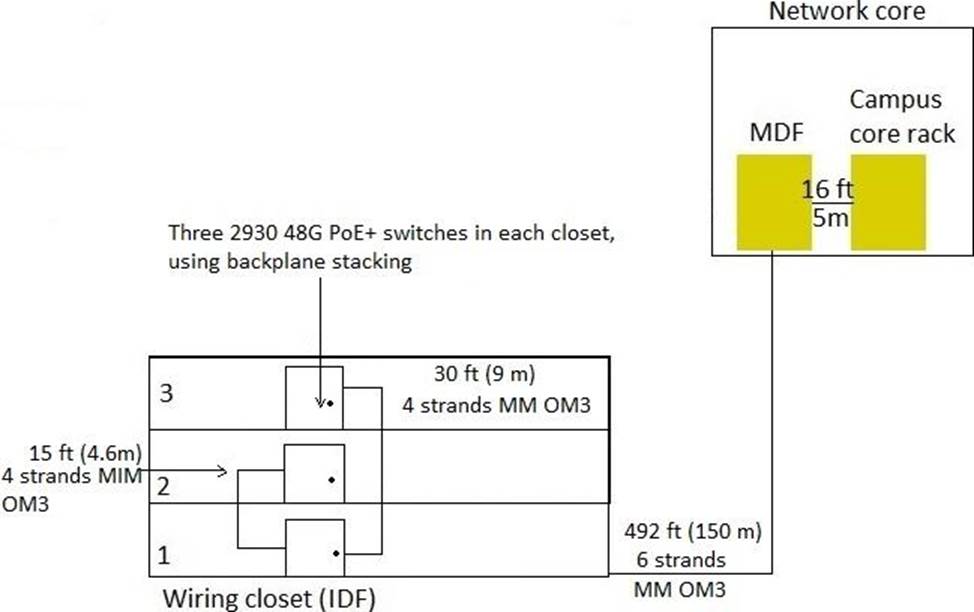
A customer needs a wired upgrade for a building on its main campus. The exhibit shows the switches that architect has selected for each closet and the existing cabling. The customer is not open to changing the cabling.
The customer requires link redundancy for the uplinks from each closet and for the links from the building to the core. In non link failure situations, the uplinks from each closet must support at least 20 Gbps, and the building as a whole must have at least 20 Gbps to the core in non link failure situations.
Which options for connecting the closets to the network core are valid? (Select two.)
- A . Connect the switch stack on each floor directly to the network core on two fiber connections per floor. Achieve this by patching the inter-floor fiber through the inter-building fiber.
- B . Add two aggregation switches in the Floor 1 closet. Connect the switch stack for each closet to the aggregation switches on two fiber links each and the aggregation switches to the core on two fiber links.
- C . Combine the nine switches on all three floors into a single switch stack with stacking cables in a ring topology. Connect two Floor 1 members to the network core with one fiber connection each.
- D . Combine the nine switches on all three floors into a single switch stack with the MM OM3 fiber cables in a ring topology. Connect two Floor 1 members to the network core with one fiber connection each.
- E . Connect the Floor 2 switch stack to Floor 1 with two fiber connections. Do the same for Floor 3. Connect the Floor 1 switch stack to the network core with two fiber connections.
A customer has phones used as wireless Voice over IP (VoIP) devices.
Which is one implication for the design?
- A . Plan policies for the phone role on MCs to give the phones a high QoS priority.
- B . Ensure a -75 GHz signal in both the 2.4GHz band and the 5GHz band across the entire site.
- C . Ensure that APs connect on Smart Rate ports to support the high bandwidth demands of the phones.
- D . Apply a bandwidth contract to the phone VLAN to limit broadcast and multicast traffic.
What is one reason to deploy an Aruba 8320 switch when compared to an Aruba 5400R switch?
- A . to support cloud-based management and guest services through Aruba Central integration
- B . to obtain a great number of options for types of ports, including PoE and non-PoE
- C . to enhance network monitoring and analytics
- D . to support Zero Touch Provisioning (ZTP)
A hospital needs a wireless solution which will provide guest access for patients and visitors, as well as for medical staff. In addition to laptops and tablets, staff have wireless voice communicator devices. Some medical equipment also connects wirelessly.
How can the network architect help to ensure that patient and visitor internet use does not interfere with more vital hospital applications?
- A . Deploy IntroSpect to monitor patient and visitor traffic.
- B . Plan a bandwidth contract for the guest role in the MC firewall.
- C . Deploy dedicated Air Monitors (AMs) at about one-fourth the density of APs.
- D . Ensure that the guest SSID has a password associated with it.
Refer to the exhibit.
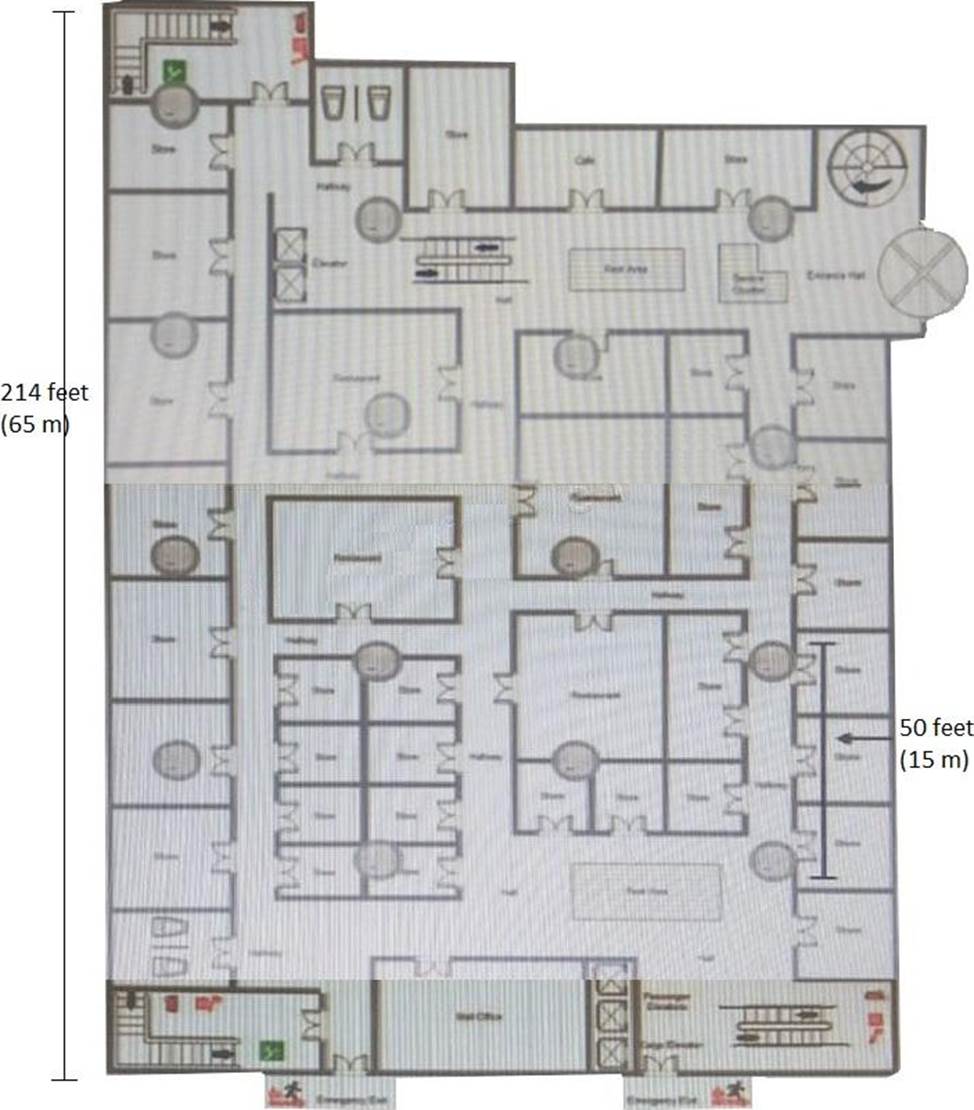
A mall has an existing Aruba solution with 15 AP-335s. The mall now wants to add Meridian and location-based services, in particular blue dot wayfinding. The customer plans to use the built-in beacon in the existing AP radios. These Meridian licenses have been proposed:
Which concern should the architect raise about this plan?
- A . Separate beacons should be deployed to provide proper coverage for wayfinding.
- B . Only the Blue Dot Nav license is required to meet the customer requirements.
- C . The customer requires wireless sensors to manage the beacons in the AP radios.
- D . The existing AP radios do not support beacon functionality.
Refer to the exhibit.
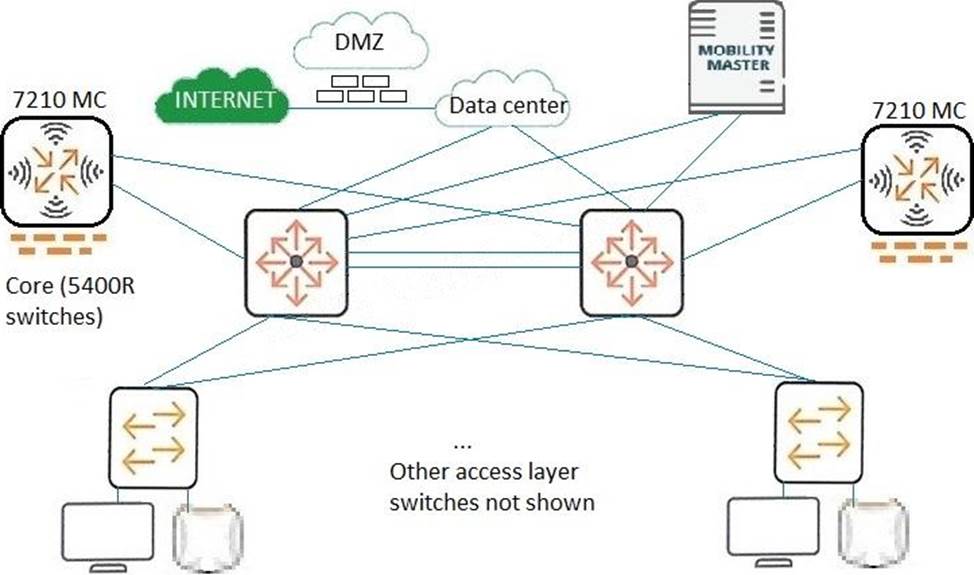
A customer needs a network upgrade.
The customer has these availability requirements for wireless access:
– One MC and one core switch can fail with immediate, stateful failover for client connections.
– Network upgrades can occur without the requirement of a maintenance window.
The exhibit shows the architecture plan.
Which technologies should the architect recommend?
- A . Clustering on MCs and VRRP on Core switches
- B . VRRP on MCs and VSF on Core switches
- C . VRRP on both MCs and Core switches
- D . Clustering on MCs and VSF on Core switches
Refer to the exhibit. A customer needs a wired network upgrade and has complained about performance issues. The architect has collected information about traffic flow on several switch ports in different locations across the network, and the results are shown in the exhibit. Each of these ports is a 1Gbps port.
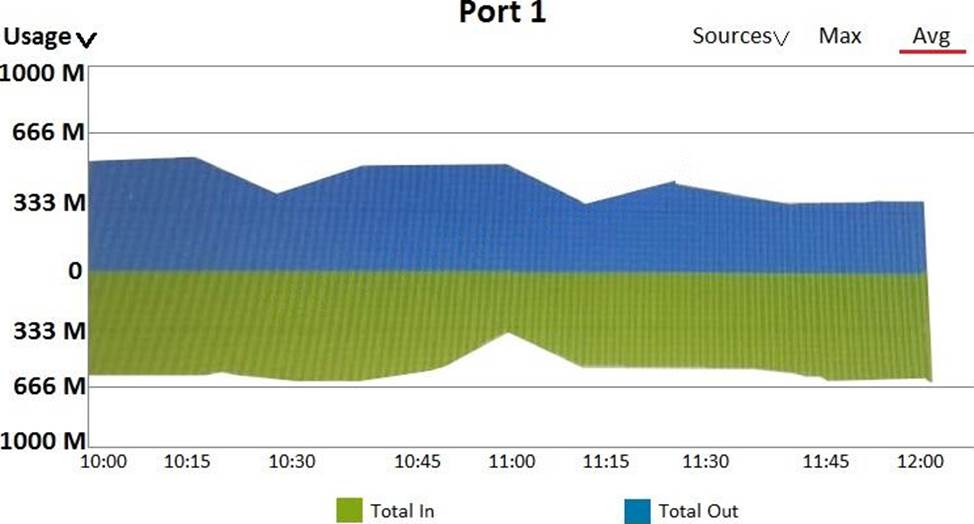
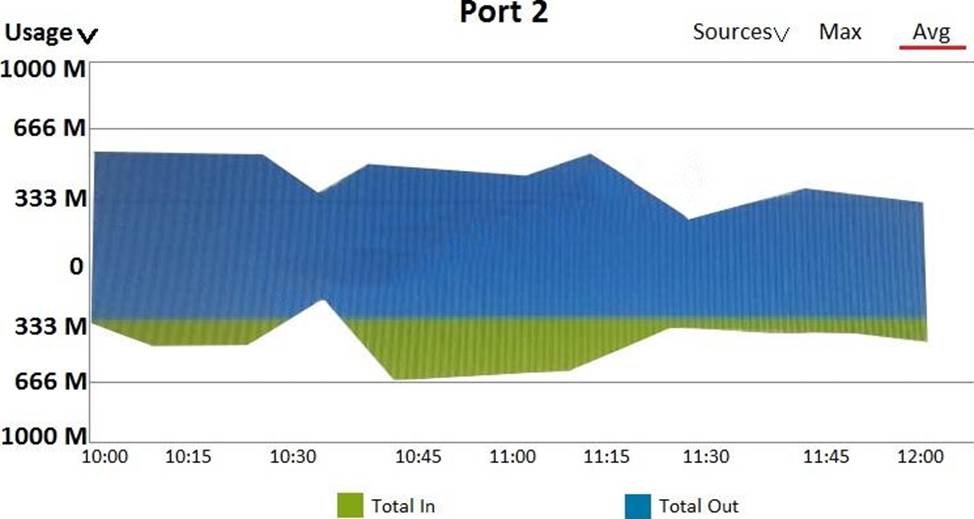
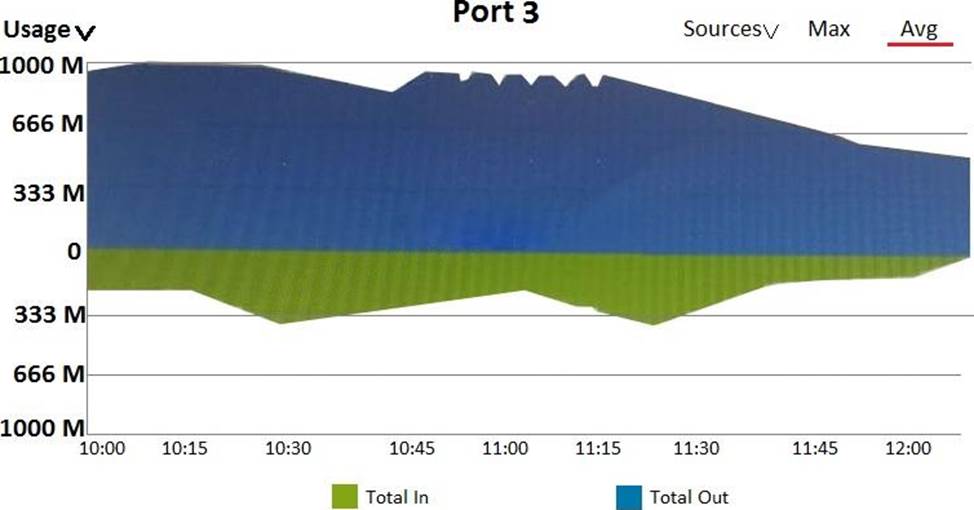
What can the architect conclude?
- A . None of these ports show any periods of congestion.
- B . Port 1 shows periods of congestion, other ports are not congested.
- C . Port 3 shows periods of congestion, other ports are not congested.
- D . All of the ports show serious congestion.
Refer to the exhibit.
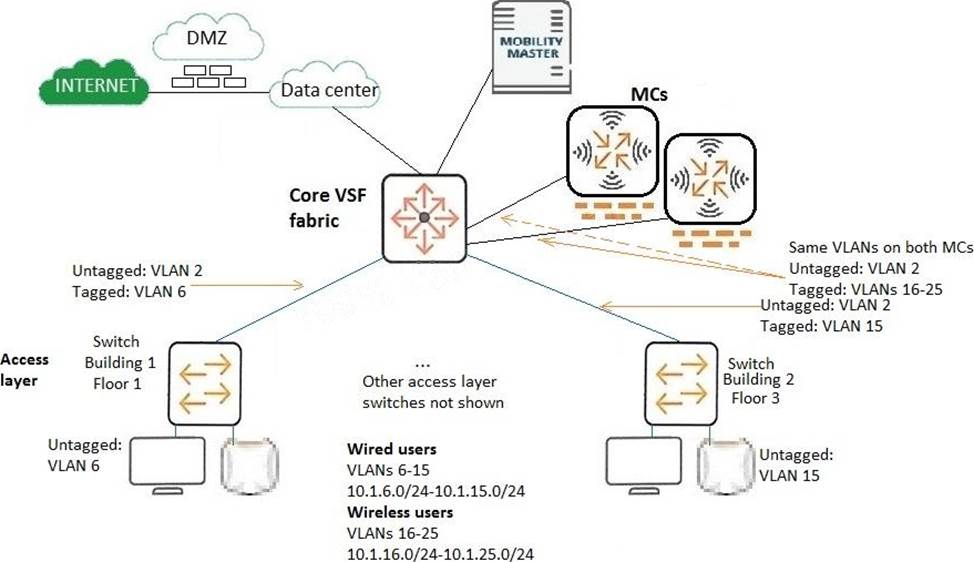
A customer needs a wireless network upgrade and has these requirements:
– Support any applications used on a wired connection
– Support up to 2500 wireless clients
– Support seamless roaming from floor to floor and building to building
– Continue to function seamlessly if one AP or controller fails
The architect has designed the local infrastructure for the network as shown in the exhibit.
Which change should the architect make to better meet customer requirements and best practices?
- A . Combine the /24 subnets for wireless and wired users into a /16 subnet.
- B . Place each controller in a different VLAN and subnet.
- C . Change the /24 subnets for wireless users into a /25 subnet.
- D . Combine the /24 subnets for wireless users into a /20 subnet.
An architect has recommended the deployment or RAPs at user home offices to provide access to the corporate LAN.
How should the architect plan the SSID for the RAPs?
- A . Same SSID and security settings as the corporate SSID
- B . any name for the SSID with MAC-Authentication
- C . any name for the SSID, which would be open; VIA is used for security
- D . same name used for the corporate SSID, but always with WPA2-Personal security
A customer has critical wired endpoints and wants to minimize the chances they will lose their connection to the network. These endpoints are dual-homed, each with two Ethernet connections that are in a link aggregation.
The architect plans to deploy two 5406R switches in the closet.
What else should the architect specify in the plan?
- A . The 5406R switches are in a VSF fabric; each switch has redundant power supplies, but not redundant management modules.
- B . The 5406R switches are not in a VSF fabric; each switch has redundant power supplies but not redundant management modules.
- C . The 5406R switches are not in a VSF fabric; each switch has redundant power supplies and redundant management modules.
- D . The 5406R switches are in a VSF fabric; each switch has redundant power supplies and redundant management modules.
Latest HPE6-A49 Dumps Valid Version with 60 Q&As
Latest And Valid Q&A | Instant Download | Once Fail, Full Refund

